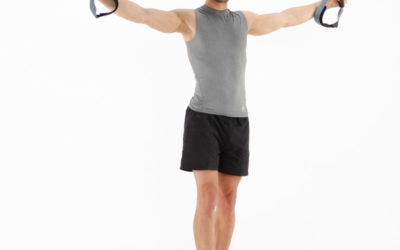Strengthen your back muscles with a Suspension Trainer
- Degree of Difficulty 60%

Suspension Training Long-Back-Pull Starting position
Short Description
- Hips, legs and arms are all stretched.
- Pull your body to an upright position using your back muscles.
- Bend legs and hips to come back to starting position.
Long Description
- The knees are flexed about 90 degree and the hip is in a right angle towards the upper legs. The back remains straight. The arms are tensed. The weight is on the heels.
- The upper body is raised up by support of the back and shoulder muscles. The arms get flexed in the elbow joint and a shoulder rotation is executed until the arms point upwards. The thorax gets wide opened.
- The body is in a light hollow back. The elbow joints are placed on shoulder level and flexed in an angle of 90 degree. The forearms are in vertical position, the palms point forward and the chest is wide opened.
- The buttocks is approximated to the bottom by a hip flexion arm stretching and shoulder rotation.
Tips
Make sure that you pull your shoulder blades actively down during the opening of the thorax, to train the shoulder and back muscles in an optimal way.
Additional exercise instructions
The Long Back Pull is an effective exercise to train the posterior shoulder, the complete back and the arms. Due to the long lever action of the arms, the exercise concerted trains the medial and lower back. This version additionally trains the rotator cuff of the shoulder joint.
Related Suspension Trainer Exercises
Reverse Fly
Butterfly Reverse belongs to the most elemental exercises for the shoulder training. A fixed and anti-slide stand is the basic requirement. Minimal changes in the inclination angle cause great differences in the load of the exercise.
Low-Row
The exercise trains the complete back muscles, both dynamic and static. The inclination angle of the body is relevant for the training load.
Lower Back Swing
This exercise trains the posterior ischiocrural muscles, the buttocks and the lower back. It requires a lot of body tension.



